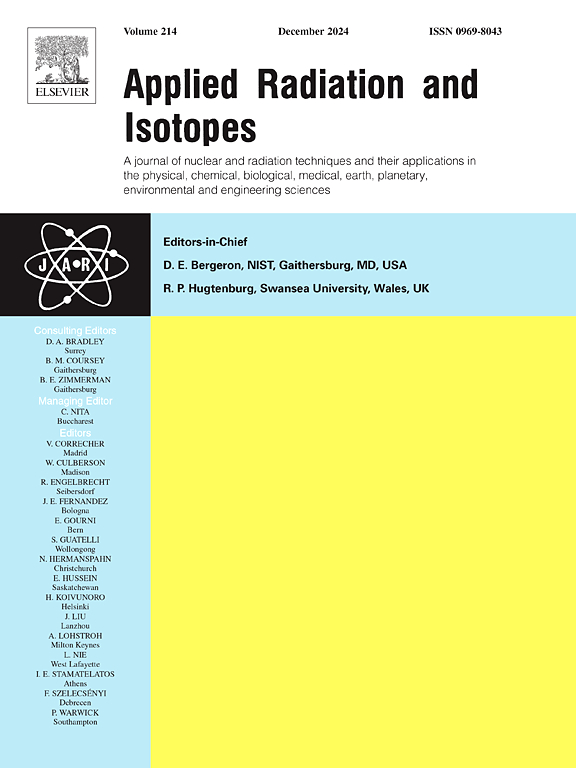Optimizing resin shielding for neutron diffractometer detectors
IF 1.6
3区 工程技术
Q3 CHEMISTRY, INORGANIC & NUCLEAR
引用次数: 0
Abstract
In nuclear techniques, specific materials are used to shield detectors. For quick scan during kinetic analysis of materials, multi-detector systems are used in neutron diffraction where borated hydrogenated-materials are used to shield detectors from the neutron background. For shielding enhancement, the B4C powder is eventually added for better protection. Then, neutron shielding calculations play a vital role in optimizing detector system design.
The present work aims to establish, by SCALE6.1 code simulation, some neutron shielding parameters of borated and non-borated resin. For an eventual use in the newly designed multi-detector system for Es-Salam neutron diffractometer, the simulation has been done for different monochromatic neutron-beams that can be used to investigate different structural properties of materials.
The neutron behavior of the C57H65O10 resin without and with 5 wt% boron has been studied for different monochromatic neutron-beam. The backscattered neutron flux, the backscattering depth and the transmission-off thickness are analyzed and evaluated. They are reduced following the B4C addition for each studied neutron-energy and a good diffraction data can be obtained. The obtained results permit to establish the corresponding shielding condition for an optimized design with the lowest mechanical loading on any neutron-scattering instrument detection-system.
优化树脂屏蔽中子衍射仪探测器
在核技术中,特殊材料被用来屏蔽探测器。为了在材料动力学分析过程中进行快速扫描,在中子衍射中使用多探测器系统,其中硼化氢化材料用于屏蔽探测器免受中子背景的影响。为了增强屏蔽,B4C粉末最终被添加以获得更好的保护。因此,中子屏蔽计算在优化探测器系统设计中起着至关重要的作用。本工作旨在通过SCALE6.1代码模拟,建立含硼和非含硼树脂的中子屏蔽参数。为了最终应用于新设计的Es-Salam中子衍射仪的多探测器系统,对不同的单色中子束进行了模拟,这些单色中子束可用于研究材料的不同结构特性。研究了C57H65O10树脂在不同单色中子束下的中子行为。对后向散射中子通量、后向散射深度和透射厚度进行了分析和评价。对所研究的每一个中子能加入B4C后,它们被还原,并得到了良好的衍射数据。所得结果可为任何中子散射仪器检测系统的最低机械负荷优化设计建立相应的屏蔽条件。
本文章由计算机程序翻译,如有差异,请以英文原文为准。
求助全文
约1分钟内获得全文
求助全文
来源期刊

Applied Radiation and Isotopes
工程技术-核科学技术
CiteScore
3.00
自引率
12.50%
发文量
406
审稿时长
13.5 months
期刊介绍:
Applied Radiation and Isotopes provides a high quality medium for the publication of substantial, original and scientific and technological papers on the development and peaceful application of nuclear, radiation and radionuclide techniques in chemistry, physics, biochemistry, biology, medicine, security, engineering and in the earth, planetary and environmental sciences, all including dosimetry. Nuclear techniques are defined in the broadest sense and both experimental and theoretical papers are welcome. They include the development and use of α- and β-particles, X-rays and γ-rays, neutrons and other nuclear particles and radiations from all sources, including radionuclides, synchrotron sources, cyclotrons and reactors and from the natural environment.
The journal aims to publish papers with significance to an international audience, containing substantial novelty and scientific impact. The Editors reserve the rights to reject, with or without external review, papers that do not meet these criteria.
Papers dealing with radiation processing, i.e., where radiation is used to bring about a biological, chemical or physical change in a material, should be directed to our sister journal Radiation Physics and Chemistry.
 求助内容:
求助内容: 应助结果提醒方式:
应助结果提醒方式:


